Two-ingredient pasta is easy to make at home. I’m sharing all my tips including making pasta with or without a food processor or pasta machine, freezing your pasta, and swapping out different flours.
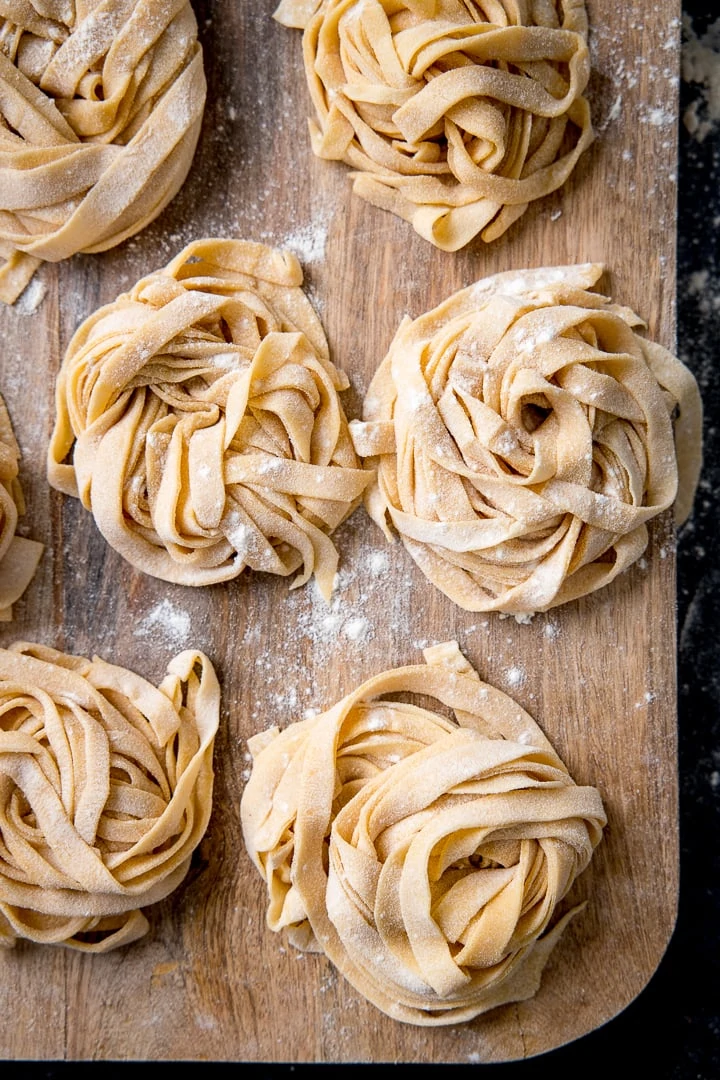
Pasta is limited on the shelves at the moment, but certain types and flour, and for the most part eggs, seem to be available.
That’s all you need to make homemade pasta.
It also happens to be really delicious pasta that feels like a gourmet treat.
If you haven’t got a pasta machine, don’t worry, you don’t need one!
A rolling pin is all you really need. However, if you have a food mixer, that’s helpful too. It’ll speed things up and take out some of the work. But it’s not essential.
Fresh Pasta Ingredients
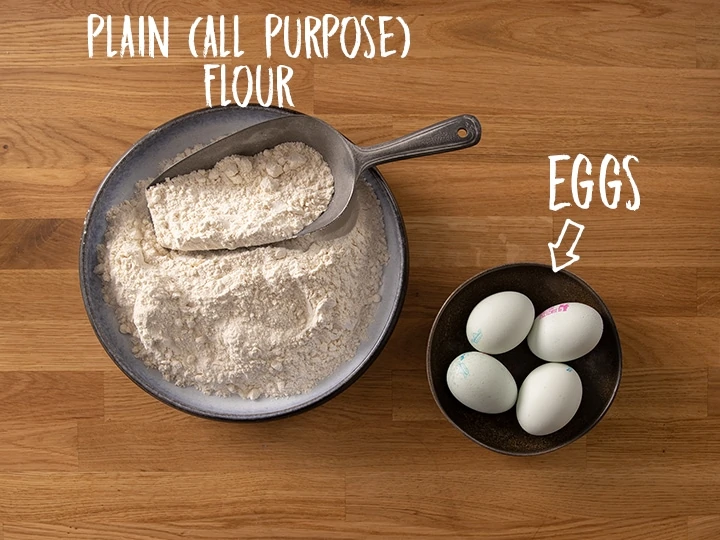
Which flour for homemade pasta?
Pasta flour or ’00’ flour is a protein-rich flour commonly used for a smoother, chewier pasta.
Semolina flour is great for a slightly rougher pasta that allows the sauce to cling to it better.
Plain or all-purpose flour is somewhere in between. It makes relatively smooth pasta with a light chewiness.
Since plain or all-purpose flour is what most people have in their store cupboards, I’m using it for this recipe. However you can swap it out like-for-like (same quantities) with ’00’ or semolina flour.
How to make it
- Place the flour and eggs in the bowl of a stand mixer. Use the dough hook and start mixing slowly until it comes together as a ball.
- Once it forms into a ball, increase the speed to medium and mix for 5 minutes, until the dough is smooth.
- Take the dough out of the bowl and wrap in clingfilm or wax paper. Place in the fridge for 30 minutes.
- Remove from the fridge and split the dough into 4 pieces.
- Using a rolling pin and roll out the dough on a lightly floured surface until the dough is as thin as you can possibly get it.
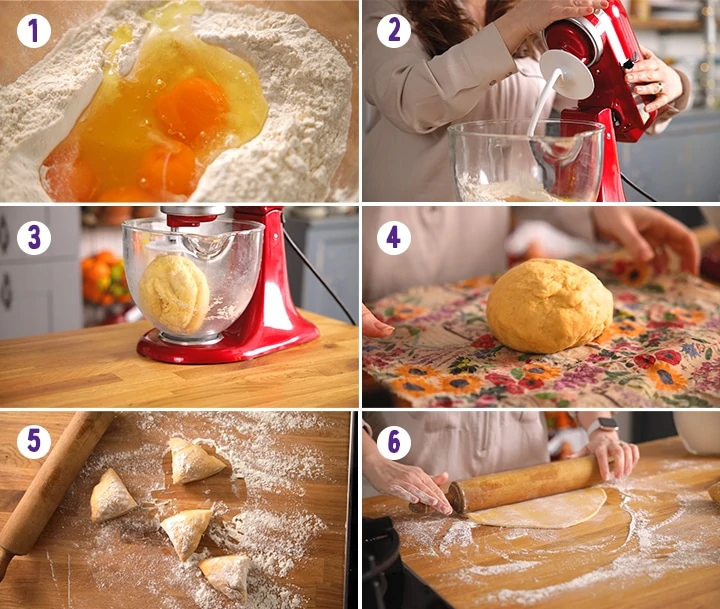
- Lightly flour the top of the dough and roll it up loosely before slicing into 1/2 cm (0.2″) thick strips.
- Use your fingers to separate out the strands and place on a plate in portions.
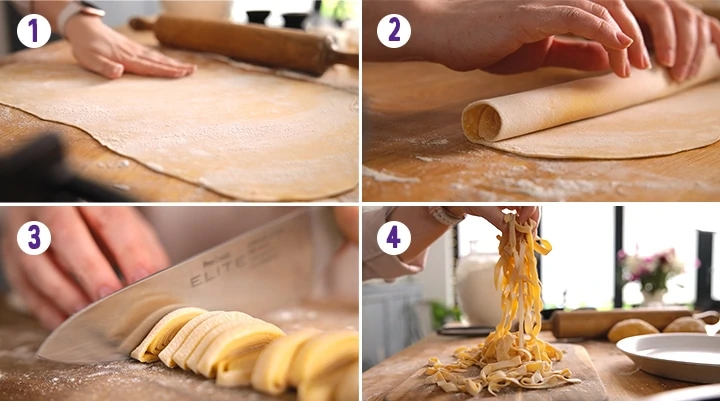
You can cook the pasta right away by placing in a large pan of boiling salted water for 3 minutes (see below for instructions for prepping ahead and storing).
This pasta is so tasty, I love to serve it simply with a drizzle of good olive oil and a sprinkling of Maldon salt. A pinch of chilli flakes adds a nice little kick too!
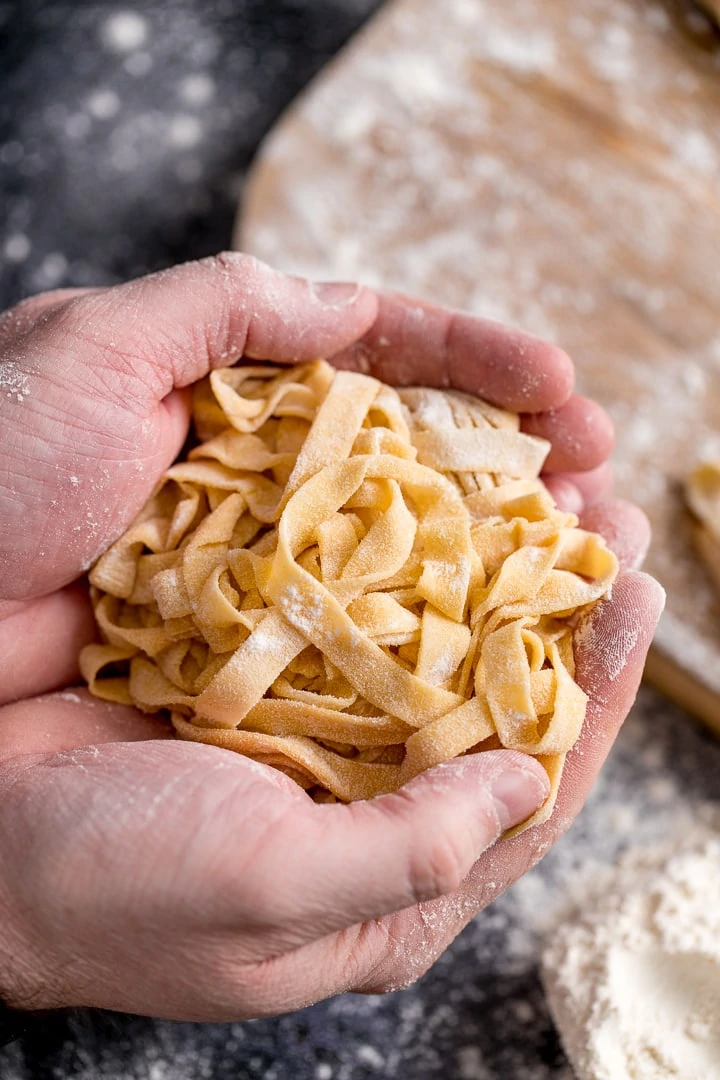
Can I make it ahead?
Yes, you can make it ahead and store it in lots of different ways.
Fresh pasta – room temperature
Make the pasta and then distribute it on a floured baking sheet/plate/tray and sprinkle it with flour. You can leave it this way, uncovered, for a few hours. Leave for longer if you want to dry the pasta completely (see more info on drying pasta below).
Time to cook from room temperature – 3 minutes.
Fresh pasta – refrigerated
If you want to make the pasta a few days ahead, you can refrigerate it too. Make the pasta then distribute it on a floured baking sheet/plate/tray and sprinkle it with flour, leave to dry for a couple of hours at room temperature, then cover and refrigerate for 2-3 days.
Time to cook from refrigerated – 3 minutes.
Drying homemade pasta
Make the pasta, then distribute it on a floured baking sheet/plate/tray and sprinkle it with flour. Dry for 24 hours, until you can snap the pasta. You should try to avoid a humid environment, as the pasta won’t fully dry out.
Once fully dried, store in a sealed container at room temperature for up to a month.
Time to cook from dried – 4-7 minutes.
Freezing homemade pasta
Make the pasta and then distribute it on a floured baking sheet/plate/tray and sprinkle it with flour. If you have it, it’s best to sprinkle it with semolina flour, as this will help stop the pasta from sticking together when you’re cooking it. If you don’t have it, just dust very lightly with regular plain/all-purpose flour instead.
Time to cook from frozen – 3-5 minutes.
Pro tip: If you’re able to, then open freeze the pasta in on the tray for 30 minutes (so it’s still a little bit pliable). Then split into portions and freeze in freezer bags or a sealed container. Freeze for up to 3 months.
What to serve with Fresh Pasta
- The rich and meaty bolognese from my spaghetti bolognese post
- Creamy steak stroganoff for an indulgent weekend dinner
- Tuscan chicken in a creamy sun-dried tomato sauce (or for a veg-based version try my Tuscan mushrooms)
- Crunchy oven-baked chicken parmesan
- Slow cooked beef goulash
- Garlic bread spaghetti (sounds strange, but it’s awesome!!)
Watch how to make it

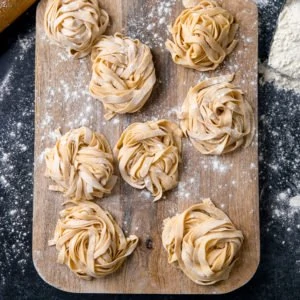
Easy Homemade Pasta - Without a Pasta Machine
Ingredients
- 420 g (3 1/4 cups) plain (all-purpose) flour See Note 1 for swaps
- 4 large eggs
Instructions
- Place the flour and eggs in the bowl of a stand mixer (see: Note 2 below for doing this bit by hand).420 g (3 1/4 cups) plain (all-purpose) flour, 4 large eggs
- Use the dough hook and start mixing slowly until it comes together as a ball. You may need to add a little splash of water or flour, depending on if the dough looks dry or sticky.
- Once it forms into a ball, increase the speed to medium and mix for 5 minutes, until the dough is smooth.
- Take the dough out of the bowl and wrap it in clingfilm or wax paper (ensure it's fully covered so it doesn't dry out) and place in the fridge for at least 30 minutes, and up to 12 hours.
- Remove from the fridge and split the dough into 4 pieces.
- Using a rolling pin (see Note 3), roll out the dough on a lightly floured surface until the dough is as thin as you can possibly get it. You should just about be able to see the shape of your hand through the dough.
- Now you can cut the pasta into any shape you want. Large rectangles for lasagna, squares for ravioli or strips for tagliatelle.
- For tagliatelle, lightly flour the top of the dough and roll it up loosely before slicing it into 1/2 cm (0.2") thick strips.
- Use your fingers to separate out the strands and place them on a plate in portions.
- To cook the pasta, place it in a large pan of well-salted boiling water. Bring back to the boil and simmer for 3 minutes. The pasta should float to the top of the water when cooked.
Video

Notes
Note 1 - Flour swaps
I'm using Plain or all-purpose flour for a relatively smooth pasta with a light chewiness.You can replace it (same quanitities) with:
- Pasta flour or ’00’ flour - which is a protein-rich flour commonly used for a smoother, chewier pasta.
- Semolina flour - which is great for a slightly rougher pasta that allows the sauce to cling to it better.
Note 2 - Making the pasta by hand
If you don't have a stand mixer, simply place your flour in a large mound on your work surface.Whisk the eggs lightly in a bowl.
Make a large well in the centre of the flour and carefully add the eggs. A little at a time, slowly incorporate the flour into the eggs using a fork until the eggs and flour are fully mixed. Use your hands to shape the dough into a ball. You may need to add a tiny splash of water if the dough is very dry and crumbly. Or add a sprinkling of flour if the dough is too wet. Knead the dough on a lightly floured surface for 5 minutes until smooth. Continue on with the rest of the recipe.
Note 3 - Rolling pin or Pasta Machine
I used a rolling pin, which works great so long as you keep the dough lightly floured and roll until it's the thinnest you can get it (it will swell a little when cooked). If you have a pasta machine then take one of the quarter pieces of dough and squash or roll it relatively flat.Set your pasta machine on the widest setting and dust the dough in flour. Then work the pasta through the pasta machine. Knock it down a setting, so it's slightly narrower, then flour the dough and go again. Continue this, reducing the setting (and flouring the dough to prevent it sticking), until your dough as thin as it can go.
Then roll and cut the dough by hand, or use the cutting setting on your machine.
Making Fresh Pasta ahead
Room temperature
Make the pasta and then distribute it on a floured baking sheet/plate/tray and sprinkle it with flour. You can leave it this way, uncovered, for a few hours. Leave for longer if you want to dry the pasta completely (see more info on drying pasta below).Time to cook from room temperature – 3 minutes.
Refrigerated
If you want to make the pasta a few days ahead, you can refrigerate it too. Make the pasta then distribute it on a floured baking sheet/plate/tray and sprinkle it with flour, leave to dry for a couple of hours at room temperature, then cover and refrigerate for 2-3 days.Time to cook from refrigerated – 3 minutes.
Drying homemade pasta
Make the pasta, then distribute it on a floured baking sheet/plate/tray and sprinkle it with flour. Dry for 24 hours, until you can snap the pasta. You should try to avoid a humid environment, as the pasta won’t fully dry out.Once fully dried, store in a sealed container at room temperature for up to a month.
Time to cook from dried – 4-7 minutes.
Freezing
Make the pasta and then distribute it on a floured baking sheet/plate/tray and sprinkle it with flour. If you have it, it’s best to sprinkle it with semolina flour, as this will help stop the pasta from sticking together when you’re cooking it. If you don’t have it, just dust very lightly with regular plain/all-purpose flour instead.Time to cook from frozen – 3-5 minutes.
Nutritional information is per serving (serves 6)
Nutrition
Nutrition information is automatically calculated, so should only be used as an approximation.
Some of the links in this post may be affiliate links – which means if you buy the product I get a small commission (at no extra cost to you). If you do buy, then thank you! That’s what helps us to keep Kitchen Sanctuary running. The nutritional information provided is approximate and can vary depending on several factors. For more information please see our Terms & Conditions.
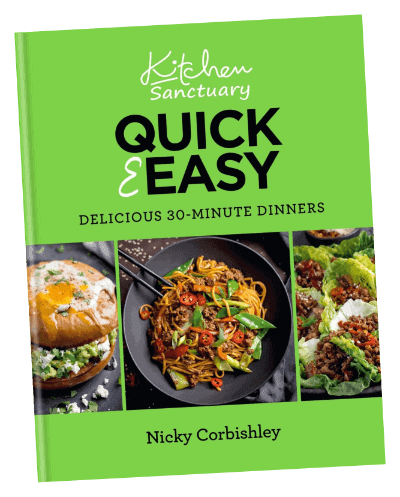
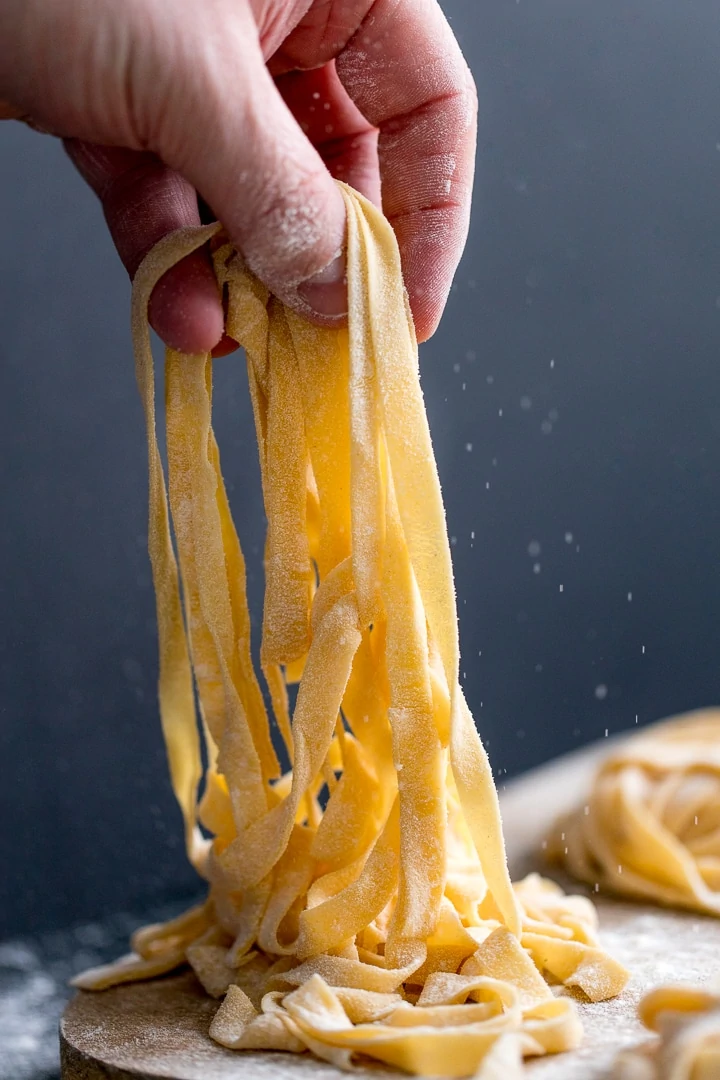

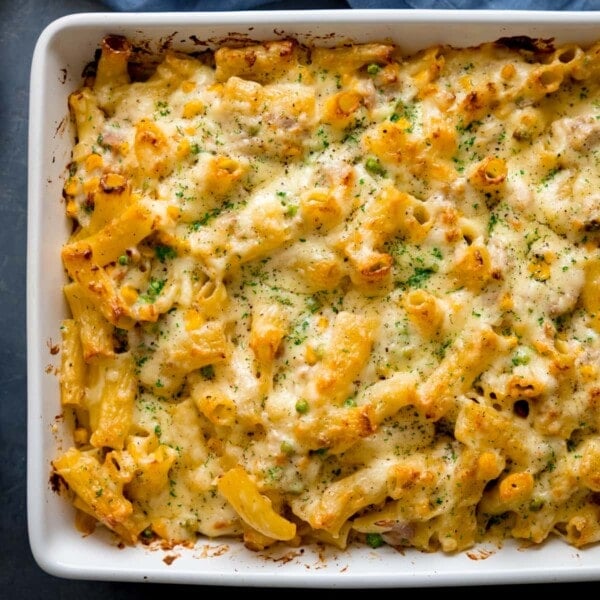
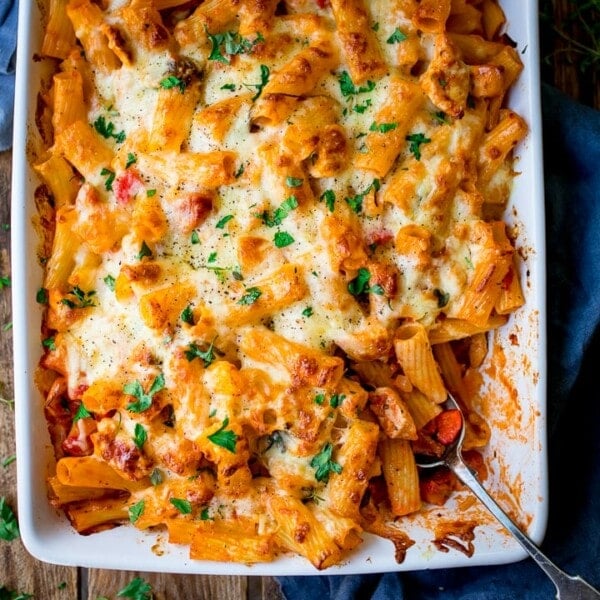
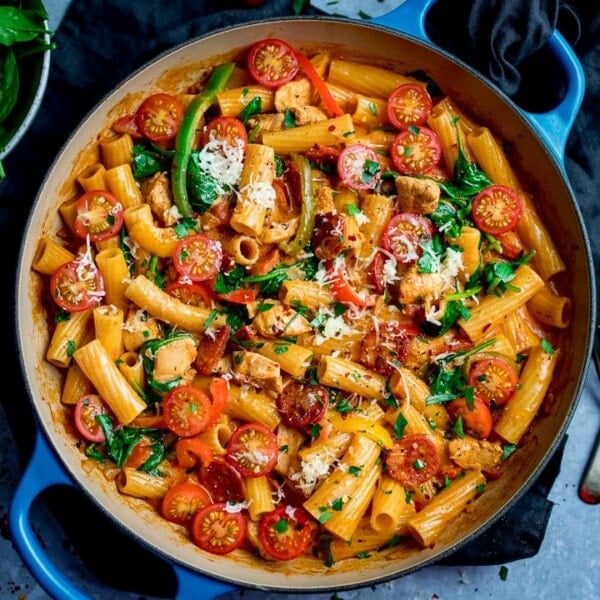
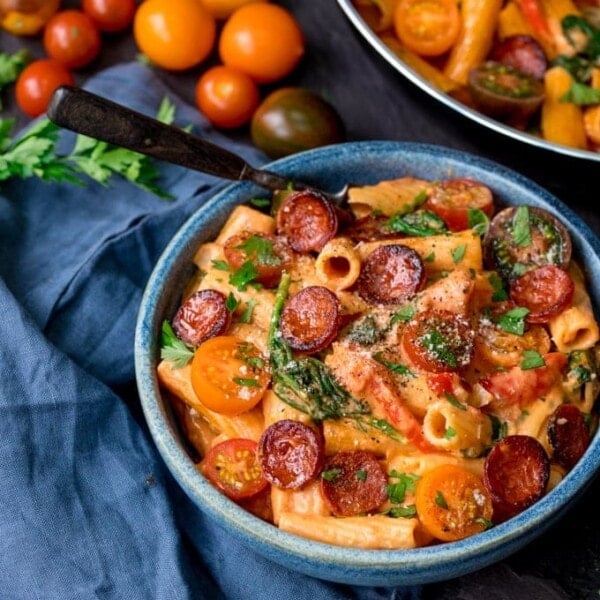
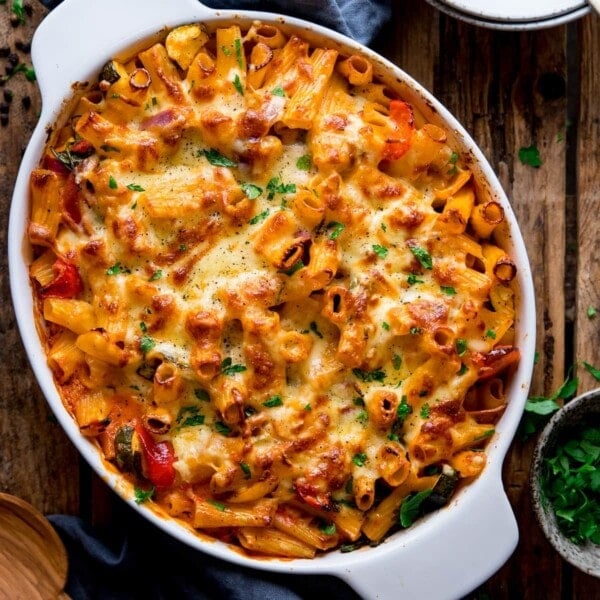
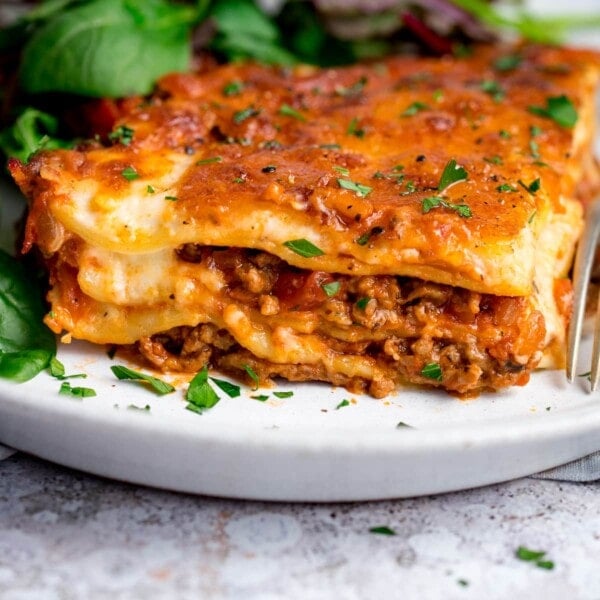
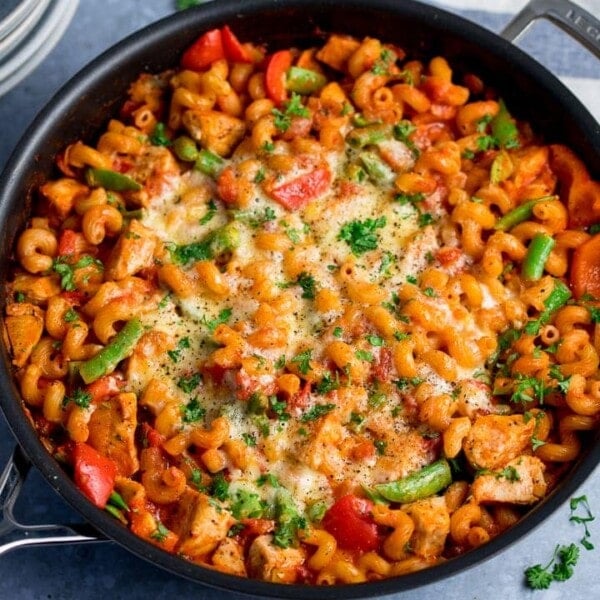
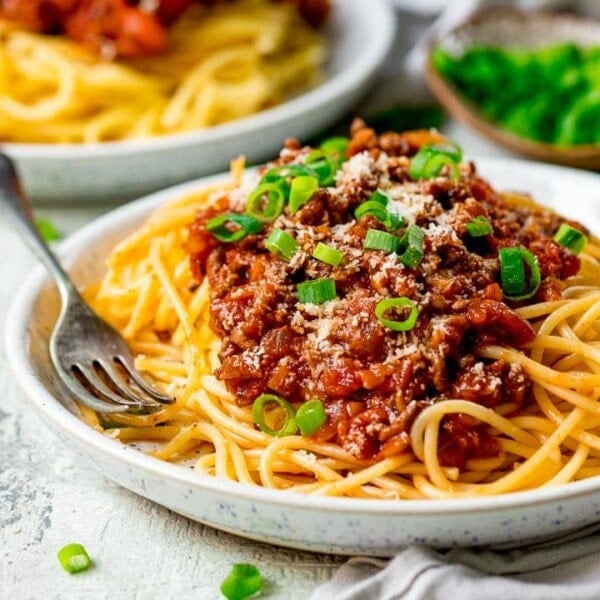







Do you think any other flours will work? My mom has a gluten allergy, and it’s killing her to give up pasta. I was just wondering if one of the “gluten-free” flours would work just as well.
This is the first recipe I’ve used that said to use a mixer & dough hook, add to a little water, as needed. So I did both, and for the first time got dough soft enough to actually roll out. Thank you for a DELICIOUS and easy pasta!
My first time making fresh pasta. Thank you for this recipe. I made a roasted garlic and lemon pepper sauce to top it and what we really loved is that we didn’t have that heavy bloated feeling after eating. I also blended in the food processor and that made it easy too. 🙂
We have made it twice and it’s delicious! Worth the effort! Yummy with pestoand grilled chicken.
First time to make homemade pasta and husband and I were impressed! Used your Bolognese sauce and will definitely make again.
Really great recipe! My husband and I made the pasta tonight as a date night. We had to add about 2 tablespoons of water to the flour/egg mixture, but other than that, we followed the recipe and it was super delicious! Will make again!